| Lockheed Martin F-22 | |
|---|---|
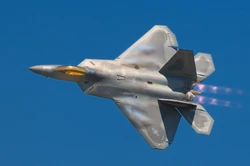 F-22 Raptor using afterburners | |
|
Role: |
|
|
Manufaturer: |
|
|
First Flight: |
September 7, 1997 |
|
Primary User: |
United States Air Force |
|
Number Built: |
195, 8 test and 187 operational |
|
Program Cost: |
$67 Billion USD |
The F-22 Raptor is a single-seat, twin-engine, fifth generation, stealth American fighter by Lockheed Martin and Boeing. The F-22 was originally an air superiority fighter, but has additional capabilities that include ground attack, electronic warfare and signals intelligence.
Development[]
Origins[]
In the 1980's, the United States Air Force developed the requirements for an Advanced Tactical Fighter to replace both the F-15 and F-16 Fighting Falcon. These ATF requirements were developed because of worldwide threats including the Soviet Union's Su-27 Flanker and Mig-29 "Fulcrum". The F-22 was required to have composite materials, advanced flight-control systems, more powerful propulsion systems, lightweight alloys, and stealth technology. In July of 1986, two contractor teams, Lockheed/Boeing/General Dynamics and Northrop Grumman/McDonnell Douglas, were selected to undertake a 50-month demonstration phase, culminating in the flight test of two prototypes, the YF-22 and the YF-23. After the 90-day flight test validation of the prototype air vehicles, the Secretary of the U.S. Air Force Donald Rice announced the YF-22 was the winner of the ATF competition on April 23, 1991.
Design[]
Characteristics[]
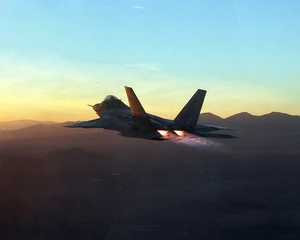
The F-22 using its F-199-PW-100 on full afterburners.
The raptor is a fifth generation fighter (fourth-generation stealth fighter according to the USAF.) It has dual afterburning Pratt & Whitney F119-PW-100 turbofans that incorporate pitch axis thrust vectoring, with a range of ±20 degrees. The max thrust of the F-22, without afterburners, is about mach 1.82, which is about 35,000 lbf(156 kN) per engine. Maximum speed, without external weapons, is estimated to be Mach 1.82 in supercruise mode. With afterburners, it is "greater than Mach 2.0" (greater than 1,317 mph, 2,120 km/h). The U.S. Air Force claims that the Raptor cannot be matched by any known or projected fighter types, and Lockheed Martin claims: "the F-22 is the only aircraft that blends supercruise speed, super-agility, stealth and sensor fusion into a single air dominance platform."
Avionics[]
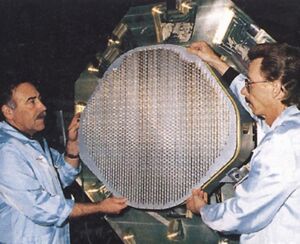
The AN/APG-77 AESA radar
The F-22's avionics include BAE Systems E&IS radar warning receiver (RWR) AN/ALR-94, AN/AAR 56 Infra-Red and Ultra-Violet MAWS (Missile Approach Warning System) and the Northrop Grumman AN/APG-77 Active Electronically Scanned Array (AESA) radar. The AN/ALR-94 is a passive receiver system to detect radar signals; composed of more than 30 antennas blended into the wings and fuselage that provide all around coverage. It was described by Tom Burbage, former F-22 program head at Lockheed Martin, as "the most technically complex piece of equipment on the aircraft." It has a greater range (250+ nmi) than the radar, allowing the F-22 to limit its own radar emissions to maximize stealth. As a target approaches, the receiver can cue the AN/APG-77 radar to track the target with a narrow beam, which can be as focused down to 2° by 2° in azimuth and elevation.
Stealth[]
The stealth of the F-22 is due to a combination of factors, including the overall shape of the aircraft, the use of radar absorbent material (RAM), and attention to detail such as hinges and pilot helmets that could provide a radar return. However, reduced radar cross section is one of five facets of presence reduction addressed in the designing of the F-22. The F-22 was designed to disguise its infrared emissions, reducing the threat of infrared homing surface-to-air or air-to-air missiles, including its flat thrust vectoring nozzles. The aircraft was designed to be less visible to the naked eye; radio, heat and noise emissions are equally controlled.
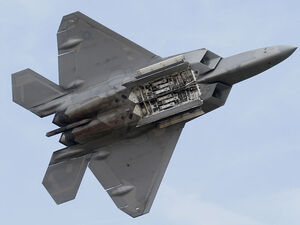
The F-22's hidden Weapon Bays
The F-22 reportedly relies less on maintenance-intensive radar absorbent coatings than previous stealth designs like the F-117. These materials are susceptible to adverse weather conditions. Unlike the B-2, which requires climate-controlled hangars, the F-22 can undergo repairs on the flight line or in a normal hangar. The F-22 features a Signature Assessment System which delivers warnings when the radar signature is degraded and has necessitated repair.
Cockpit[]
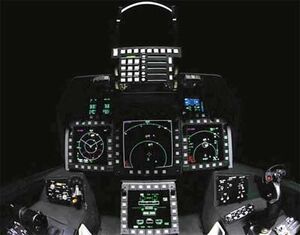
The F-22's HUD
The F-22 features a glass cockpit with no analog flight instruments. The primary flight controls are a force-sensitive side-stick controller and a pair of throttles. The monochrome head-up display offers a wide field of view and serves as a primary flight instrument for the pilot; information is also displayed upon six color liquid crystal display panels. The canopy's dimensions are approximately 140 inches long, 45 inches wide, and 27 inches tall (355 cm x 115 cm x 69 cm) and weighs 360 pounds. In August 2006, the Air Force Packaging Technology Engineering Facility (AFPTEF) was tasked with the design of a new shipping and storage container for the fragile F-22 Canopy.
The Raptor has integrated radio functionality for communicating on standard frequencies, the signal processing systems are virtualized rather than a separated hardware module. Radio functions are inactive during the strictest emissions control protocols to maintain stealth; at lower EMCON levels the pilot may use the radio at will. There has been several media reports on the F-22's inability to communicate with other aircraft and funding cuts on integrating the new data-linking standard, MADL. Voice communication is possible, but not data transfer yet. However, the Joint Tactical Radio System (JTRS), the software-defined radio project, was cancelled in October 2011 (before delivery to the F-22).
Specifications[]
General Characteristics[]
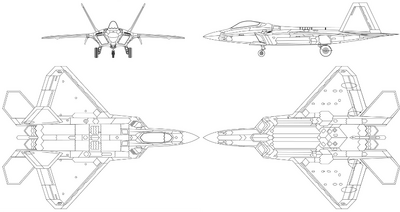
Schematics of the F-22.
- Crew: 1
- Length: 62 ft. 1 in. (18.9 m)
- Height: 16 ft. 8 in. (5.08 m)
- Wingspan: 44 ft. 6 in. (13.56 m)
- Empty Weight: 43,340 lb (19,700 kg)
- Loaded Weight: 64,460 lb (29,300 kg)
- Max. Takeoff Weight: 83,500 lb (38,000 kg)
- Powerplant: 2 × Pratt & Whitney F119-PW-100 Pitch Thrust vectoring turbofans
- Dry Thrust: 23,500 lb (104 kN) each
- Thrust with Afterburner: 35,000+ lb (156+ kN) each
- Fuel Capacity: 18,000 lb (8,200 kg) internally, or 26,000 lb (11,900 kg) with two external fuel tanks. About 3,050 gal or 20,333 lb JP-8 internally.
Performance[]
- Maximum Speed: Mach 2.25 (1,500 mph/2,410 km/h)
- Supercruise speed: Mach 1.82 (1,220 mph/1,963 km/h)
- Surface Ceiling: 65,000 ft.
Payload[]
Note: The following are mission-type weapon requirements.
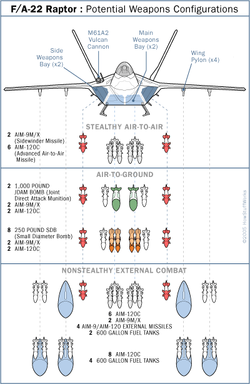
Possible F-22 armament.
- Guns: 1x 20 mm M61A2 Vulcan 6-barreled Gatling Cannon in starboard wing root (Concealed). 480 rounds.
- Air to Air Loadouts:
- Air to Ground Loadouts:
- 2x AIM-120 AMRAAM
- 2x AIM-9 Sidewinder for air to air combat
- 2x 1000lb JDAM or
- 8x 250lb GBU-39 Small Diameter Bombs
- Hardpoints(rare, due to limiting stealthful effectiveness): 4× under-wing pylon stations can be fitted to carry 600 U.S. gallon drop tanks or weapons, each with a capacity of 5,000 lb.
